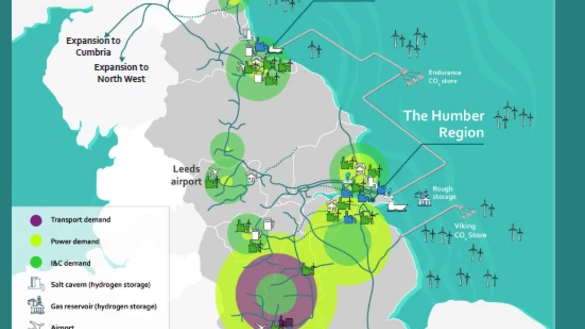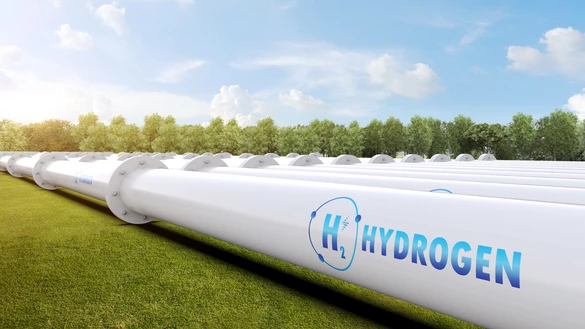- Back
- Balancing
- Capacity
- Charging
- Connections
- Data and operations
- Land and assets
-
Insight and innovation
- Back
- Home
- Insight and innovation
- Transmission innovation
- Summer Outlook
- Winter Outlook
- Gas Ten Year Statement (GTYS)
- Gas Future Operability Planning (GFOP)
- The future of gas-fired generation
- Understanding within-day behaviour
- Identifying future drivers of change
- Changing supply patterns
- Future of gas
- Stakeholder resources

Leading-edge hydrogen innovation to benefit from over £40m of funding
National Gas has been granted £43m of funding by Ofgem’s Strategic Innovation Fund for two innovation programmes which will play a critical role in Britain’s transition towards net zero emissions, and further unlock gas’s role as a key enabler for a clean energy future.
The company’s HyNTS Compression and Deblending projects have been awarded £33m and £10m respectively. This will enable the delivery of the £56m programme of work to be delivered at the HyNTS FutureGrid facility at DNV Spadeadam in Cumbria.
HyNTS Compression (HyNTS being “Hydrogen in the NTS”) will establish whether existing gas compressor units on the high-pressure National Transmission System (NTS) can be repurposed and adapted to work with different blends and 100% hydrogen. Repurposing existing compressors could save tens of millions of pounds for consumers at every compressor station, compared to the costs of new-build.
HyNTS Deblending will demonstrate gas separation technology to ‘deblend’ gases within the NTS to enable delivery of hydrogen for transport. This will involve showcasing how blended transmission gas can be taken through separation, purification, and compression processes, culminating in refuelling hydrogen vehicles across a range of sizes and types. The solution will enable refuelling infrastructure to directly link to the network accelerating the availability of hydrogen for transport applications such as HGVs, trains, buses and maritime vessels.
The successful projects under the “Beta” round of the Strategic Innovation Fund initially received funding for feasibility studies in the ‘Discovery’ phase and then for proof-of-concept work in the ‘Alpha’phase. They are supported by a range of partners including DNV, Siemens Energy, Cullum Detuners, Premtech, Cardiff University, , Northern Gas Networks, and SGN, (for HyNTS Compression); and DNV, HyET Hydrogen, Element 2, Element Energy, Cadent, Northern Gas Networks, Wales and West Utilities, and SGN (for HyNTS Deblending).
Both projects will further develop the HyNTS FutureGrid facility in Cumbria (National Gas’s physical hydrogen test facility), providing technical evidence to enable Project Union. This project will demonstrate how 2,000km of the NTS could be repurposed as Britain’s “hydrogen backbone” in a decarbonised energy future.
The Compression and Deblending projects are funded by energy network users and consumers through the Strategic Innovation Fund, a programme run by the UK’s independent energy regulator Ofgem managed in partnership with Innovate UK. Beta projects are multi-million-pound large scale demonstrations delivered over several years with the aim of become a transformative ‘business as usual’ product, process or service.
Jon Butterworth, CEO, commented:
“These ambitious, innovative endeavours have the potential to accelerate the transition to net zero emissions and generate massive cost savings for consumers in the process. We look forward to taking each project forward and bringing hydrogen into the mainstream of Britain’s clean energy future.”
Further detail on the projects:
- HyNTS Compression
The National Transmission System (NTS) currently provides a resilient supply of natural gas to homes, businesses, and industry across the UK. The gas is moved by a complex compression system comprised of 24 compressor stations and 74 individual compressor units. To transport and store hydrogen across the UK, compression is required to provide flow, and deliver hydrogen when and where it’s needed.
The HyNTS FutureGrid Compression project will develop evidence that our existing compressor fleet can be modified for hydrogen use in a cost-effective manner, by providing a technical demonstration at DNV’s Spadeadam facility.
A decommissioned gas turbine representative of the current fleet will be fuelled by different blends of hydrogen up to 25%, then following modifications, 100% hydrogen. This will provide technical and safety evidence for the repurposing of our current gas turbine fleet. Following this, the full compression system including the power turbine, gas compressor and the cab and ancillary equipment will undergo offline testing at the Future Grid hydrogen test facility, to demonstrate that the assets can be repurposed for hydrogen blends and 100% hydrogen. A compression test loop will be constructed out of decommissioned NTS assets to test the compressor systems in a range of hydrogen scenarios.
This will demonstrate the capability of both the rotating machinery package and the full system and will give an understanding of how these would operate on a hydrogen network.
This will support the creation of a wider strategy for the NTS compression system and how it will adapt to hydrogen in the network.
- HyNTS Deblending
National Gas have been considering the role of the gas networks in the energy transition, and the associated potential use cases. Hydrogen has been identified as one of the solutions to help achieve net zero by 2050 and in the transitional period, is likely to be blended with natural gas to provide energy.
The HyNTS FutureGrid Deblending project focuses on the deblending of gases within the high-pressure National Transmission System (NTS) to enable delivery to transport applications. Without this technology, refuelling of transportation assets will be limited to the use of locally produced hydrogen, until the gas networks can transport 100% hydrogen. This will limit large scale hydrogen infrastructure availability and therefore the speed of transition for the transport industry.
The project will showcase the full process, starting with taking blended transmission gas through the Electrochemical separation system which purifies and compresses the gases, culminating in refuelling hydrogen vehicles of a variety of sizes. The project will also develop low-cost mobile solutions for deblending and purification that can be migrated around the UK networks as we transition to 100% Hydrogen.
Gas separation technology has historically only been used in specific chemical industrial processes and has never been trialled on a variable gas network. We need to demonstrate that the technology can operate with fluctuations in the gas inlet of temperature, low, pressure and composition.
Alongside the transport application, this technology can also be used to remove hydrogen from a blend with natural gas, which will help to meet the varying customer requirements expected during the transition period.
Our vision is that in the future, businesses could apply to connect to the NTS with the sole purpose of extracting hydrogen for a refuelling station connected to a large-scale road, rail, bus depot, or for use in the marine and aviation sectors.
NOTES FOR EDITORS
About the Ofgem Strategic Innovation Fund
The purpose of Ofgem’s Strategic Innovation Fund is to support network innovation that will contribute to achieving Net Zero rapidly and at lowest cost; deliver real net benefits to network companies, energy users and consumers; and help the UK to become a ‘Silicon Valley’ of energy. It aims to work with other public funders of innovation so that activities appropriately funded by energy users and consumers are coordinated with activities funded by Government. The Fund is delivered through a partnership with Innovate UK.
About Ofgem
Ofgem is Britain’s independent energy regulator. Its role is to protect consumers now and in the future by working to deliver a greener, fairer energy system. We do this by: • Working with Government, industry and consumer groups to deliver a net zero economy at the lowest cost to consumers. • Stamping out sharp and bad practice, ensuring fair treatment for all consumers, especially the vulnerable. • Enabling competition and innovation, which drives down prices and results in new products and services for consumers.
About Innovate UK
Innovate UK is the UK’s innovation agency, part of UK Research and Innovation. It drives productivity and economic growth by supporting businesses to develop and realise the potential of new ideas, including those from the UK’s world-class research base.



